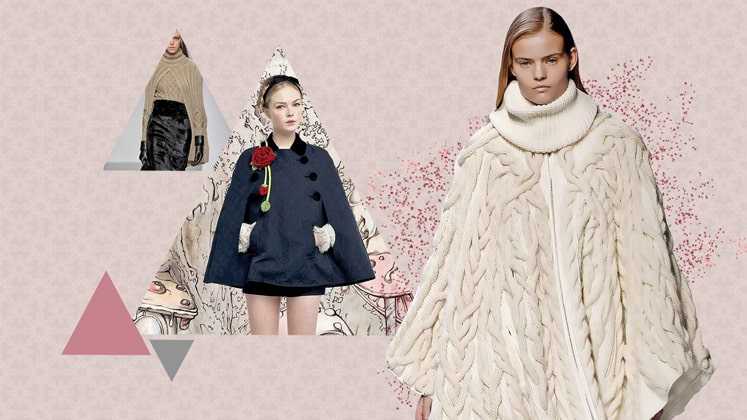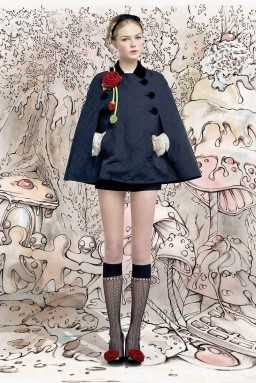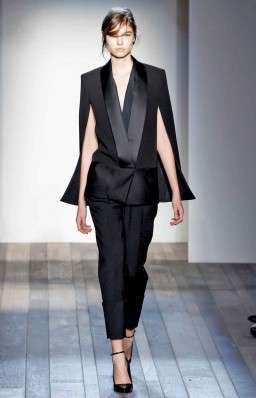
A cape is deemed as the perfect transition piece to go from a warm to cool climate and also a great way to add elegance and a stylish retro vibe to any fall wardrobe, which can be made extremely practical if slits are incorporated for moving one’s arms. The dramatic has been meeting the handy in the form of a cape being fashioned into dresses, tops and jackets for a few seasons now, in various different fabrics, but Autumn/Winter ’14-15 runways had a new incarnation – the ‘knit cape’. While some exporters are more than familiar with the knitwear trend already working on collections, for a few others it looks like a missed opportunity as they stick to conventional styles for the winter, oblivious to the possibilities of the style…
Even today, the moment one mentions Little Red Riding Hood, the image that comes to mind is that of her often copied, red cape jacket. The definitive style made it big, spreading winter warmth at the Fall ’13-14 runways and completely coming into its own for A/W ’14-15. Average jeans and tops were teamed with elegant capes to make the outfit look instantly dressy and put-together. Designers went from military-inspired to classic Little Red Riding Hood as Raoul presented an olive wool and suede cape, Yigal Azrouël went for a deep maroon wool and cashmere one, Red Valentino’s ink blue was in stretch wool jacquard and velvet, Mulberry turned heads with their oxblood leather version and Etienne Aigner’s wool cape with leather sleeves and belt was announced as a favourite for the figure-conscious consumers. Clued into the trend, Vijay Sanon, Proprietor, A.P. Handicrafts says, “We have done a lot of capes in our past collections, in wool and cotton, with different variations of hoods, belts, etc.”


Indian exporters have expanded their selection of fabrics by “manufacturing capes in cotton-viscose, viscose-nylon and acrowool, with a few pieces mixed with lurex yarn, in addition to jacquards to satisfy eveningwear requirements,” informs Ujjwal Garg, Director, Garg Acrylics Ltd., adding that in his opinion, the longer loose ones are trending right now, with an attached belt to give it shape around the waist. Following the same pattern, Vivek Khandelwal, Owner, Patterns India shares that sporting short crisp capes was initially in fashion but now it has shifted to longer ones and experimentation with different shapes and collars keeps happening, in the same vein, they are trying out new fabrics too. “We are using poly-georgette, moss crepe, lycra, jacquards and even net schiffli to make capes; and we include value addition depending on which price bracket the clientele falls under.”
While a cape immediately lends a luxurious jet-set vibe, it is often seen as something uncomfortable as it restricts movement of the arms but this myth has proved to be wrong time and again. The billowy trend was present in theatrical versions, as well as, sportier ones where the tailored and sleek look is maintained while, simultaneously, creating slits to increase movement. Victoria Beckham, Saint Laurent and Burberry, are a few of the designers who created classic slit versions in black. While both, with and without slit stay in demand, Vivek adds that they mostly try to involve a slit for increased comfort, which may be ¾th or full in length.
Following Pre Fall’s mania of cape coats, designers have transcended to knit capes for constructing roomy throwovers with a visibly cozy demeanour. While the ones in flat knits have come across as sweater kimonos – in some cases, printed and in others, with thick cable knits –circular knits too make a promising appearance. Avoiding the costume-like look, capes in neutrals and basic colours such as black/grey, cream/white and browns were seen with maximized versatility. To carry off a minimal look, the colours of the ensemble should be in shades of coral tones or monochromatic, which helps in downplaying the extravagant look of a cape. Vivek shares his colour scheme for the trend, “We are going for off-whites, black, German blues and playing with various geometric prints.”
The versatility of the cape trend lies in the fact that it can be merged with other garments, and including coats. Parmod Aggarwal, Director, Protext Plastic Pvt. Ltd. informs, “For Autumn/Winter ’14-15, pullovers and cardigans without hoods is what is taking up maximum place in my collection.” He reminds us that cardigans have also found a way with the trend being spotted on the Fall ’14-15 runways, where they have been constructed on the lines of long cape coats with sleeves and droopy shoulders. Another popular of the season – a pullover, which A. Kochhar, Director, Mercury Knits swears by, takes us back to the form-fitting pullovers with an attached cape shoulder trail or ponchos delivered in blanket fabric, ending in tassels.
Though capes envelop, comfort and cut an impressive silhouette, but for a few they still seem like a new phenomenon, preferring to remain focused on classic coats as preferred outerwear. “Long, classic coats are back in fashion and that is what we are manufacturing for outerwear,” says Jai Singh Sethia, Director, Nash Fashion India Ltd.
Sunil Ramchandra Kokare, Senior Merchandiser, Opera Clothing Pvt. Ltd. believes that short coats in cottons or blazers in suiting fabrics are the preferred outerwear and claims that none of his buyers has asked for the cape look yet.

Post a Comment